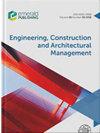Application of stacking ensemble machine learning algorithm in predicting the cost of highway construction projects
IF 3.9
2区 工程技术
Q1 ENGINEERING, CIVIL
Engineering, Construction and Architectural Management
Pub Date : 2021-06-28
DOI:10.1108/ecam-02-2020-0128
引用次数: 14
Abstract
PurposeThe purpose of this study to apply stacking ensemble machine learning algorithm for predicting the cost of highway construction projects.Design/methodology/approachThe proposed stacking ensemble model was developed by combining three distinct base predictive models automatically and optimally: linear regression, support vector machine and artificial neural network models using gradient boosting algorithm as meta-regressor.FindingsThe findings reveal that the proposed model predicted the final project cost with a very small prediction error value. This implies that the difference between predicted and actual cost was quite small. A comparison of the results of the models revealed that in all performance metrics, the stacking ensemble model outperforms the sole ones. The stacking ensemble cost model produces 86.8, 87.8 and 5.6 percent more accurate results than linear regression, vector machine support, and neural network models, respectively, based on the root mean square error values.Research limitations/implicationsThe study shows how stacking ensemble machine learning algorithm applies to predict the cost of construction projects. The estimators or practitioners can use the new model as an effectual and reliable tool for predicting the cost of Ethiopian highway construction projects at the preliminary stage.Originality/valueThe study provides insight into the machine learning algorithm application in forecasting the cost of future highway construction projects in Ethiopia.堆垛集成机器学习算法在公路建设工程造价预测中的应用
目的将堆叠集成机器学习算法应用于公路建设项目成本预测。设计/方法/方法将线性回归、支持向量机和人工神经网络三种不同的基本预测模型自动优化地组合在一起,并以梯度增强算法为元回归器,建立了叠加集成模型。结果表明,所提出的模型对最终项目成本的预测误差值非常小。这意味着预测成本和实际成本之间的差异非常小。模型结果的比较表明,在所有性能指标中,堆叠集成模型优于单一集成模型。基于均方根误差值,叠加集成成本模型比线性回归、向量机支持和神经网络模型分别产生86.8、87.8和5.6%的准确结果。研究局限/启示本研究展示了堆叠集成机器学习算法如何应用于建筑项目成本预测。估算人员或从业人员可以将新模型作为预测埃塞俄比亚公路建设项目前期成本的有效可靠的工具。独创性/价值该研究为机器学习算法在预测埃塞俄比亚未来公路建设项目成本方面的应用提供了见解。
本文章由计算机程序翻译,如有差异,请以英文原文为准。
求助全文
约1分钟内获得全文
求助全文
来源期刊

Engineering, Construction and Architectural Management
Business, Management and Accounting-General Business,Management and Accounting
CiteScore
8.10
自引率
19.50%
发文量
226
期刊介绍:
ECAM publishes original peer-reviewed research papers, case studies, technical notes, book reviews, features, discussions and other contemporary articles that advance research and practice in engineering, construction and architectural management. In particular, ECAM seeks to advance integrated design and construction practices, project lifecycle management, and sustainable construction. The journal’s scope covers all aspects of architectural design, design management, construction/project management, engineering management of major infrastructure projects, and the operation and management of constructed facilities. ECAM also addresses the technological, process, economic/business, environmental/sustainability, political, and social/human developments that influence the construction project delivery process.
ECAM strives to establish strong theoretical and empirical debates in the above areas of engineering, architecture, and construction research. Papers should be heavily integrated with the existing and current body of knowledge within the field and develop explicit and novel contributions. Acknowledging the global character of the field, we welcome papers on regional studies but encourage authors to position the work within the broader international context by reviewing and comparing findings from their regional study with studies conducted in other regions or countries whenever possible.
 求助内容:
求助内容: 应助结果提醒方式:
应助结果提醒方式:


